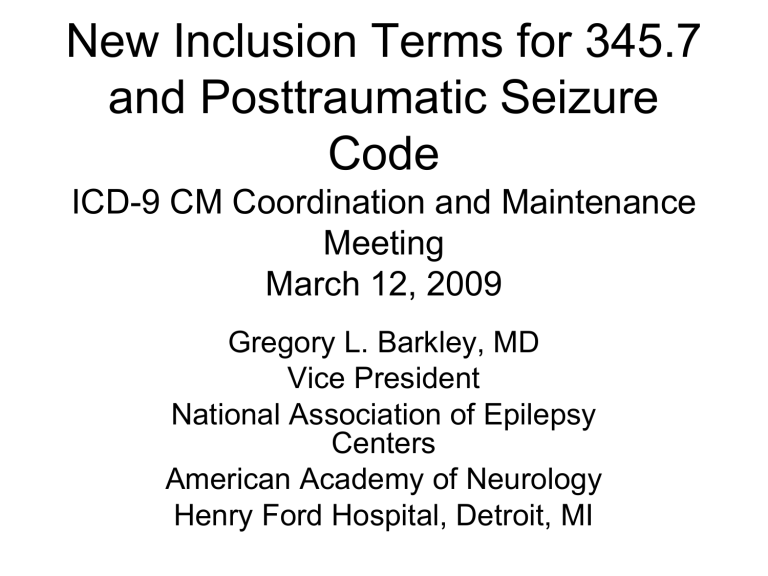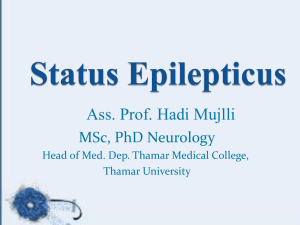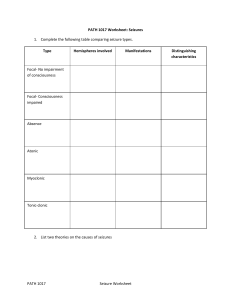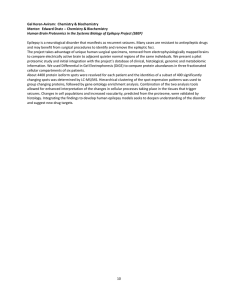
New Inclusion Terms for 345.7 and Posttraumatic Seizure Code ICD-9 CM Coordination and Maintenance Meeting March 12, 2009 Gregory L. Barkley, MD Vice President National Association of Epilepsy Centers American Academy of Neurology Henry Ford Hospital, Detroit, MI Seizure - 780.39 • A seizure is a paroxysmal behavioral spell generally caused by an excessive disorderly discharge of cortical nerve cells • Epileptic seizures range from clinically undetectable (“electrographic seizures”) to convulsions. • The symptoms vary depending upon the part of the brain involved in the epileptic discharge • Most seizures last for about 1 minute Epilepsy - 345 • Epilepsy is a syndrome of two or more unprovoked or recurrent seizures on more than one occasion • Epileptic syndromes are characterized by: – The behavior during the seizure(s) (semiology) – The age of onset – Etiology, if known – EEG characteristics of the seizure type(s) Status Epilepticus • Defined as a prolonged seizure state – Continuous epileptic activity – Serial seizures without return to normal state of consciousness between seizures • Three Status Epilepticus Codes – 345.2 Petit Mal Status Epilepticus – 345.3 Grand Mal Status Epilepticus – 345.7 Epilepsia partialis continua 345.7 Epilepsia Partialis Continua • Kojevnikov's epilepsy (I have never seen this term used) • Refers to a continuous partial seizure without alteration in consciousness – e.g. clonic activity of a digit – In effect, this is simple partial status epilepticus • Current index terms under Epilepsy, status (grand mal) 345.3 – Focal motor 345.7 – Psychomotor 345.7 – Temporal lobe 345.7 345.7 is missing terms for partial status epilepticus • There is not an index term for [complex] partial status epilepticus – Often seen in status epilepticus in association with acute brain lesions such as strokes • A commonly used clinical term is “nonconvulsive status epilepticus” • The clinical syndrome is of a patient with altered mental status and clinical and/or EEG evidence of partial status epilepticus, a so-called twilight state Proposed index terms for 345.7 • Partial Status Epilepticus – Most clinicians will document this as • Complex partial status epilepticus • Simple partial status epilepticus • Some may drop the “epilepticus” • No need to have “complex” or “simple” in index – I think that this should be the definition term rather than EPC to be consistent with 345.2 and 345.3 • Nonconvulsive Status Epilepticus • Add terms to exclusions for 345.3 • Also propose eliminating the 5th digit for intractability on 345.7 to be consistent with 345.2 and 345.3 Acute Symptomatic Seizures vs. Late onset Epilepsy • Early seizures after acute brain derangement are symptomatic of the disturbance of brain function – Can be thought of as “reactive seizures” – Trauma, stroke, encephalitis, alcohol withdrawal – Do not predict the later development of epilepsy • Seizures beginning weeks to years later represent the development of epilepsy as a late effect and coded as such, 907.0, 438.9, 139.0 – Also coded for partial epilepsy, 345.4x or 345.5x Request for Code for Posttraumatic Seizures • Propose adding 780.3x – – Posttraumatic seizure(s) Do not code with epilepsy, 345.0-345.9 • Code first rules should apply to avoid confusion – – Code first, the intracranial injury, 850-854 Alternatively, Code first, the seizure • Epidemiological and prognostic importance



